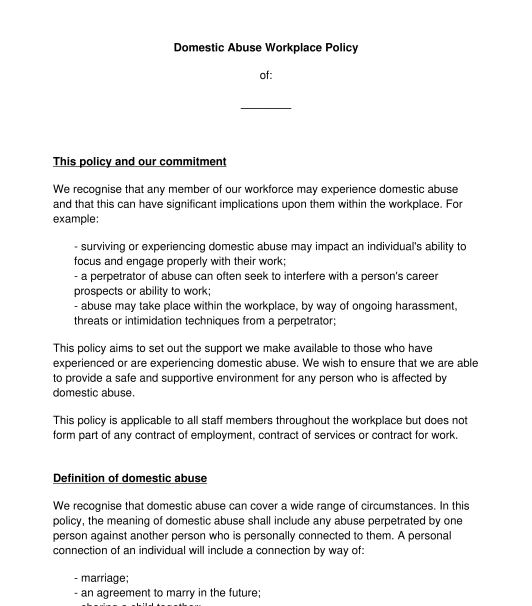 03/09/2025
03/09/2025

Answer a few questions and your document is created automatically.

Your document is ready! You will receive it in Word and PDF formats. You will be able to modify it.

 03/09/2025
03/09/2025
 Word and PDF
Word and PDF
 3 to 5 pages
3 to 5 pages
This document is a policy document which can be used by organisations in the United Kingdom to show their commitment and appropriate approach to supporting its workplace with issues relating to domestic abuse. To ensure inclusivity, the policy covers all staff members regardless of their employment status (for example workers, employees etc).
Domestic abuse has now been given statutory definitions separately in Scotland, England and Wales, and Northern Ireland, in the context of criminalising domestic abuse. Domestic abuse can cover a whole range of behaviours perpetrated towards an individual by another person who is personally connected to them (often as partners or spouses). The statutory definitions are set out slightly differently in each jurisdiction, however abusive behaviour could be characterised by any of the following:
This policy document can include information such as:
The government has previously published an open letter to employers. The letter encouraged employers to ensure that signs of domestic abuse can be spotted and to help staff to feel more comfortable raising the issue of domestic abuse. The letter also highlighted the importance of staff receiving appropriate support and that the support available should be clear for all to see. As a result, it is extremely useful for an organisation to hold a policy, such as the one contained in this document, to illustrate this.
There is no legal requirement for the policy document to be signed, although it may be a positive step for an organisation to take in order to show its commitment and endorsement of the contents of the policy.
Once the policy has been finalised, it should be stored in a place which can easily be accessed and referred to by staff members (for example on the intranet, or staff handbook etc). Staff members should be notified of the location of the policy.
The organisation may also wish to consider revising other policies which will be relevant to the matter of domestic abuse, such as its health and safety policy or its remote work policy.
The most relevant legal provisions are:
The following guidelines are also useful for organisations to consider:
You fill out a form. The document is created before your eyes as you respond to the questions.
At the end, you receive it in Word and PDF formats. You can modify it and reuse it.
Guides to help you
Workplace Domestic Abuse Policy - Sample, template
Country: United Kingdom